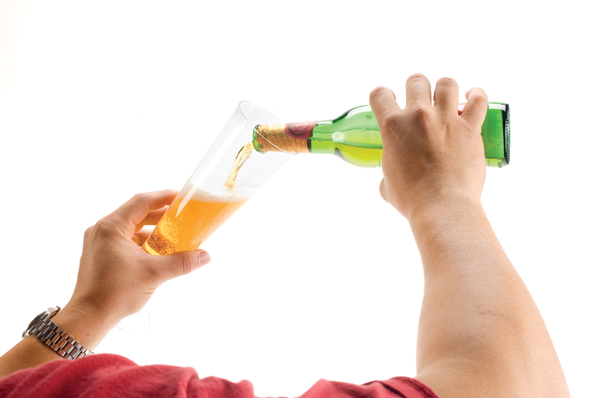Beer Anatomy–Pilsner
Words: Mike Velez
As seen in Issue #1 of Beer Magazine
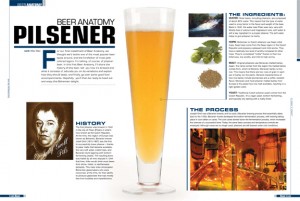
For our first installment of Beer Anatomy, we thought we’d tackle one of the most popular beer types around, and the forefather of most pale-colored lagers. I’m talking, of course, of Pilsner beer. In this first Beer Anatomy, I’ll share the history of this beer, tell you how it’s brewed and what it consists of, educate you on its variations and explain how they should taste, and finally, go over some good food accompaniments. Hopefully, you’ll then be ready to head out and enjoy this Bohemian delight.
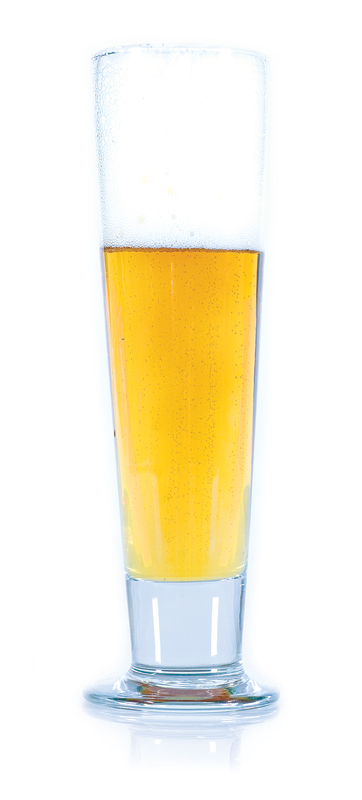
History
The first Pilsner was brewed in 1842 in the city of Plzen (Pilsen) in what’s now known as the Czech Republic. At the time, this region of Europe was known as Bohemia. Bavarian brewer Josef Groll (1813-1887) was the first to successfully brew Pilsner – thanks to paler malts that became available, the very soft water, noble hops, and Bavarian-style lagering with bottom-fermenting yeasts. The resulting brew was hailed by all who enjoyed it. Until that time, folks would drink most beers from stone, metal, or earthenware tankards. This clear brew showcased Bohemian glassmakers who were renowned, at the time, for their ability to produce glassware that was mostly free from bubbles and imperfections.

The Ingredients:
Water: Most beers, including Pilsners, are composed of about 90% water. This means that the type of water used is a key factor in the flavor and weight of the beer. Back in 1842, the water near Plzen was very, very soft. Mostly free of calcium and magnesium ions, soft water is still a key ingredient in a proper Pilsner. The soft water helps to give Pilsner its clarity.

Hops: Bohemian or Czech Pilsners use Saaz noble hops. Saaz hops come from the Saaz region of the Czech Republic and possess a pleasant and mild aroma. They have a relatively low level of acidity compared to other hops. They’re considered “noble” thanks to their low bitterness, low acidity, and mild to high aroma.
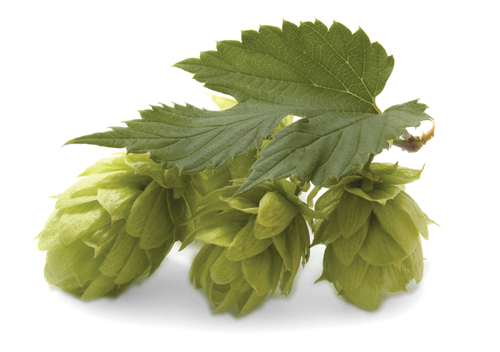
Malt: Original Pilsners use Moravian-malted barley. Again, the name comes from the region the malted barley comes from, which is Moravia. Moravian barley is two-row. This means that there are two rows of grain in each ear of barley (on the plant). General characteristics of two-row barley include plumpness and a softer, sweeter flavor. Moravian and most Pilsner-malted barley from Europe is the palest two-row malt available, resulting in a light golden color.
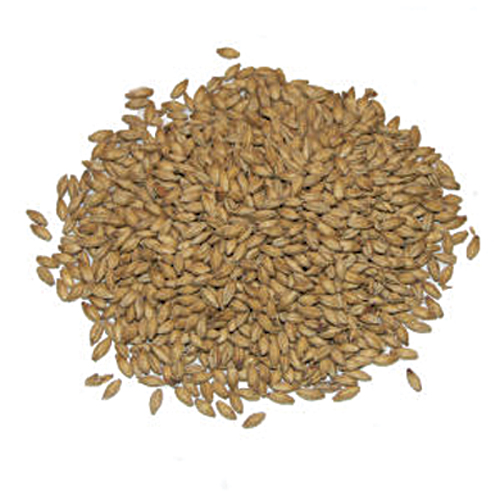
Yeast: Traditional Czech Pilsner yeast comes from the Czech Republic. It’s a lager yeast, bottom fermenting, and typically dry tasting with a malty finish.
The Process
Joseph Groll was a Bavarian brewer, and he used a Bavarian brewing process that essentially dates back to the 1400s. Bavarian monks developed the bottom fermentation process, with brewing taking place in cool cellars or caves. The cool caves slowed down the fermentation process, which increased the chances of a successful brew. Today, the same basic process and temperature controls are employed. Although caves are no longer used, Pilsners are still brewed under cold conditions.
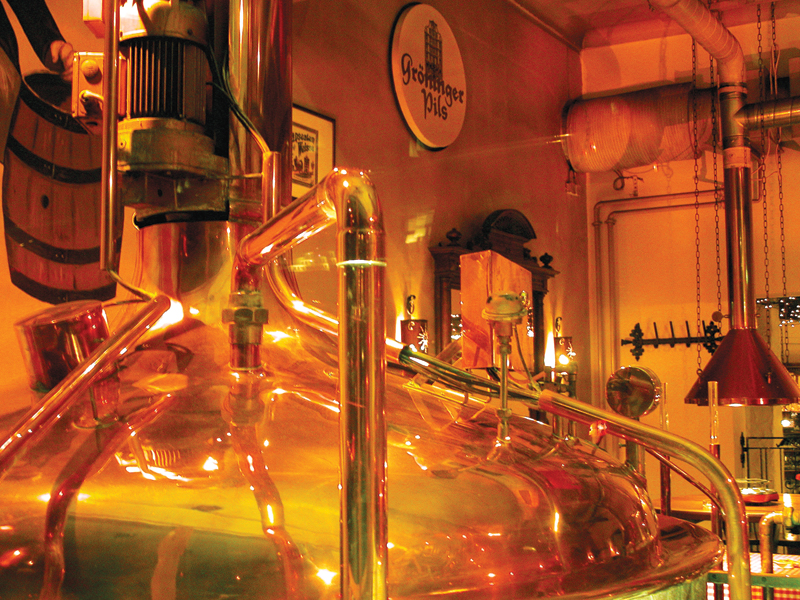
Variations
Aside from the traditional Bohemian or Czech Pilsner, there are two other popular variations: European and American.
< European
Most European Pilsners hail from Germany and Holland. German Pilsners will often use Hallertau noble hops instead of Saaz, and are produced with water containing more sulfates. The result is typically a slightly drier taste than Czech Pilsners.

American >
A version of Pilsner was first brewed in the United States by immigrant Germans who brought the process and yeast with them in the 1850s. Unlike European and Czech Pilsners, American Pilsner is brewed with up to 30% corn or rice adjunct. Also, the barley used is often six-row rather than the traditional two-row. These variations in ingredients will give a grainy sweetness for Pilsners using corn, and a crisper, more neutral taste in those using rice. “Classic” American Pilsner is hard to come by. Many American craft brewers brew European- or German-style Pilsners. However, the classic American lagers first brewed in the 1850s were the basis for most American pale lagers, which are the most popular beers poured today. Brands like Budweiser, Miller High Life, Corona, Michelob, Rolling Rock, and many others can trace their lineage to the classic American Pilsner.
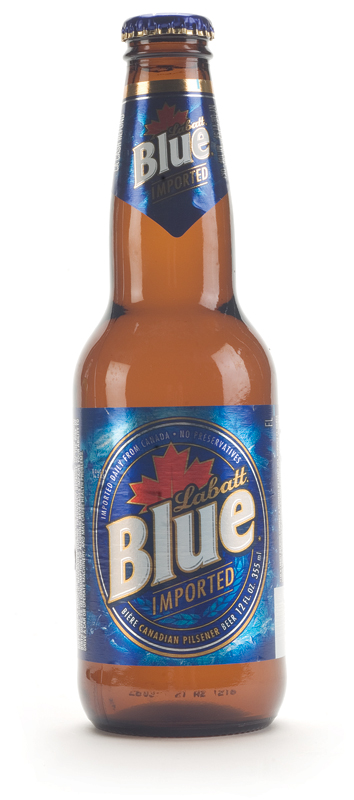
Serving Pilsner
Glass: A nice Pilsner is a beautiful looking beer, and Pilsner glasses exploit these good looks. A Pilsner is best enjoyed in a, you guessed it, Pilsner glass. A Pilsner glass is tall with a cone shape. The shape of the glass helps to focus the hop aroma and maintain a good head. A properly poured Pilsner at the right temperature should maintain its head all the way through, and the glass is key to helping make this happen. Bring the glass temperature down a bit by rinsing it for five seconds under cold running water, then dry it quickly.
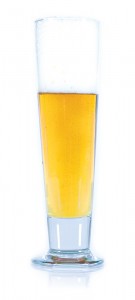
Temperature
Pilsners are best served very cold. Exact temperature depends on the brewer, but most Pilsners are best enjoyed between 45º and 48º F. If the beer is served too warm, the flavors may be too intense; if served too cold, you wonít enjoy the complexities of the brew.

Pouring a Pilsner
Draught
Hold a clean flute at a 45º angle, place the tap close to the inside edge of the glass, and open the tap fully. You want to accomplish this in one pour along the glass wall to prevent breaking the beer stream. You don’t want any distance from the tip of the tap to the glass. When the beer reaches the lip of the glass, close the tap and straighten the glass. You should be left with a nice clean pour with little head. To produce a nice creamy head, place the tap just above the surface of the beer and open the tap; the pouring beer should drive the foam up from underneath the head. An ideal head should be about an inch thick.
Bottle
A good Pilsner should never be consumed from a bottle. A bottle won’t release the full flavor of the beer or the aroma, nor will you enjoy a proper head. Start by opening the bottle gently, and don’t shake or disturb the beer. Hold the bottle at a 45º angle, and with the glass almost horizontal, pour the beer down the side, aiming at the middle of the slope of the glass. When the bottle is half empty, straighten the glass and pour directly into the center. Slowly pull the bottle up and away from the glass to add distance between the two. This will create a good head. Pour the remaining beer into the glass quickly and control the flow to create a nice inch thick head.
STEP 1
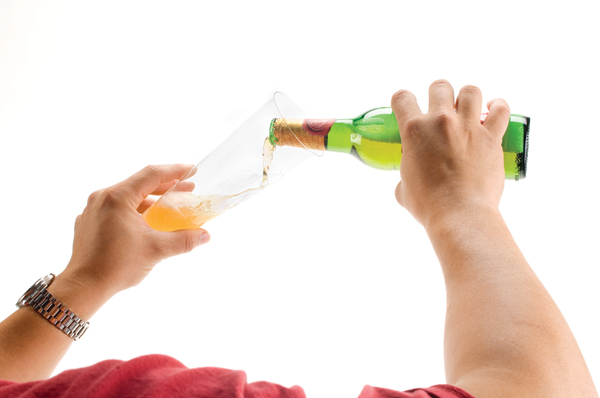
Step 3
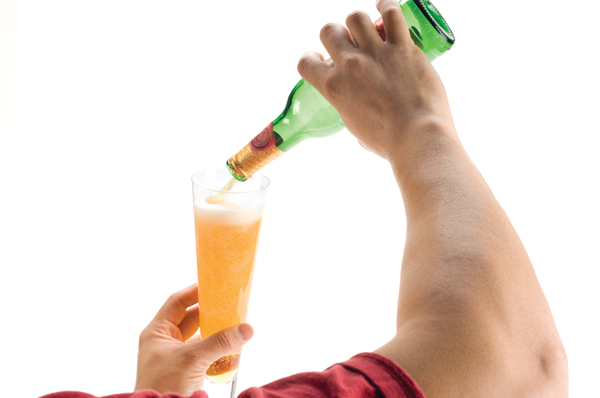
Characteristics
< Appearance
A traditional Bohemian Pilsner should have a very pale gold to deep burnished gold color with extreme clarity. European Pilsners should be straw to light gold. The head should be creamy white with very tiny bubbles, and long lasting. American Pilsners should be yellow to deep gold, exhibit bright clarity, and have a substantial long-lasting white head.

< Smell
If you were to close your eyes and get your nose right over a Pilsner, your senses would quickly paint you a picture of acres of barley being lit by the morning sunrise. Like a cool breeze, the fresh scent of grain is inviting to the senses and can be known to induce a watering of the palate (Pavlovian effect). The tiny white bubbles in the head help to emit this fragrance, which has been described as a floral bouquet with a rich, complex malt smell. You shouldn’t smell any fruity esters. Esters are compounds that form through the fermentation process. European Pilsners differ in that they typically have a light grainy malt character and a more spicy, hoppy bouquet. Initially, there may be a sulfury aroma; this is due to the water and/or the yeast. American Pilsner may have a corn-like or sweet maltiness, but when rice is the adjunct, the smell is more neutral. You may detect a medium to moderately high hop aroma.
< Taste
Ah, finally, what should a good Pilsner taste like? The first sip is very light and crisp, alluding to the warmth of rich grain that flows from your taste buds through the effervescence and into your nose. It is typically served very cold and provides a refreshing feeling as your thirst is quenched. A good Pilsner is complex, with distinctive, yet soft and rounded bitterness. The bitterness is prominent but never harsh, and doesn’t linger. The aftertaste is a nice balance between hops and malt. European Pilsner is crisp and bitter, with a dry to medium-dry finish. American Pilsner has a malty flavor similar to the other variations, but slightly lighter in intensity thanks to the adjunct. Sometimes the corn adjunct will add some sweetness and offset the hop bitterness. Rice-based brews are crisper, drier, and lack the sweetness. The light taste and lack of sweetness make Pilsners a very agreeable beer to a wide array of palates.
Food Pairing
Pilsners are a great beer to enjoy with poultry or fish, depending on how the meal is prepared. Pilsners tend to pair easily with the more complex or spicy food varieties, like buffalo hot wings or Cajun cuisine. The hops cleanse the palate nicely between bites and help coat the tongue, fighting the sting of spicy foods. Shellfish and crayfish are complimented by a Pilsner’s tastes as well. The high carbonation and mild hoppiness refrain from overpowering the flavor of crab, lobster, shrimp, oysters, and clams. The Pilsner also provides a pleasantly zesty but light contrast to grilled fish.
Common Pilsners
Czech: Pilsner Urquell, Budweiser Budvar (sold here as Czechvar)
European: Heineken, Bitburger Pils, Bohemia, Grolsch, Beck’s,
Victory Prima Pils
Classic American: Labatt’s Blue (yes, it’s Canadian)
American brewed: Dogfish Head’s Golden Shower Imperial Pilsner, CooperSmith’s Bohemian Pilsner, Dock Street Bohemian Pilsner Beer, Gordon Biersch Pilsner, Niagara Falls Saaz Pilsner, Riverside Golden Spike Pilsner, Rock Bottom Pilsner, Pyramid Coastline Pilsner

IBU ABV
Czech Pilsners > 35-45 4.2% – 5.2%
European Pilsners > 25-45 4.4% – 5.2%
American Pilsners > 25-40 4.5% – 6%



